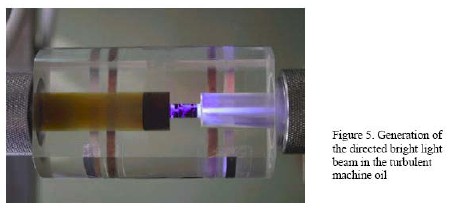The thread started by k c dias discribing the clem engine has got me excited. It may be possible to develop a hybrid Clem/Papp engine.
How this hybrid might be configured as follows:
But some background about recent LENR system experimentation describing a new kind of energy-producing device was announced at the 12th International Conference on Cold fusion by Hyunik Yang of Hangyang University in South Korea and his colleagues.
The device as presented is basically a closed loop around which oil is pumped, and forced through a plastic nozzle near Mach 1. In association with the oil flow, a discharge develops in the vicinity of the nozzle, which is readily seen by eye.
The simplest version of the cell looks something like a vintori tube.

Oil flows in under pressure on the left, into the cell where it is forced through a nozzle inside the cell, and then exits on the right.
The basic claim associated with excess heat as presented at ICCF12 involves a comparison of the thermal power, as determined from thermal and pressure measurements taken on either side of the cell combined with measurements of the flow velocity, to the electrical power input to the pump.
In response to a videotape of the device, Tom Dolan provided the following narrative: "A boron-doped oil at 30 atm appeared to have a color that is tawny; and that at over 40 atm, it is white; while at over 60 atm it is clear, with a plasma jet downstream of the orifice. At 70-80 atm, there is a bright blue beam 6 mm in diameter, and at over 90 atm a green glow appears upstream of the orifice. Hard X-rays were observed from the luminous region. The researchers claim that excess heat is generated from fusion reactions (possibly protons plus boron-11) during the collapse of cavitation bubbles, and they [claim to have] detected He-4 emission lines from the cavitating fluid."

When running, a discharge appears in the cell. In addition, cavitation bubbles are observed in the oil flow on the exit side of the cell. Hard x-rays were observed from the luminous region. The researchers claim that excess heat is generated from fusion reactions (possibly protons plus boron-11) during collapse of cavitation bubbles, and they detected He-4 emission lines from the cavitating fluid.
Proposal for a hybrid Papp engine
A hybrid system is proposed to combine the Papp engine with the Yang device as follows:
A dielectric mineral oil will produce superatomic clusters when subjected to supersonic decompression through a pinhole nozzle. When so processed at sufficiently high pressures; the oil will vaporize into a gas.
If a supersonic fuel injector is added to the Papp engine which includes a mix of noble gases, this vaporized mineral oil gas discharge will catalyze superatomic cluster formation in these noble gases when the oil vapor stream enters into the noble gas envelop from the head of the high pressure oil injection supersonic nozzle. If no oxygen is present, combustion of the oil vapor does not occur and no oil is consumed.
One development that makes this hybrid possible at the current time is the development of a high pressure fuel injector that can produce a pressure of 160,000 PSI or 11031 atmospheres.
Compared to the 100 atmospheres required by the Yang device (about 100 times more), there is more than enough pressure needed to vaporize the mineral oil into cavatation bubble production.
http://www.dieselpowermag.com/tech/0905dp_green_diesel_corp_fuel_injectors/http://blogs.dieselpowermag.com/6636119/diesel-engines/diesel-power-helps-green-diesel-corp-secure-30-million-deal/In this plan, the fuel injector would fire just before the plasmoid discharge. The plasmoid would excite ion explosion in the oil/noble gas mix to provide a pressure pulse to the cylinder head without any consumption of the mineral oil.
Excess noble gas clusters (also boron if added) not subject to ion exposition produced by the plasmoid would enrich the oil over time and be carried in the oil sump at the bottom of the cylinder.
Additives could be added to the oil and noble gas envelope for the purpose of experimentation. This includes hydrogen, boron, and deuterium.
Patent for the 160,000 PSI fuel injector.
http://www.rexresearch.com/kukler/kukler.htmVideo
https://www.youtube.com/watch?v=aZH0bbpswlACompany Name: green diesel corp
Contact Person: ron kukler
About Us: pollution free diesel fuel injection systems
Country: Australia
Company Overview
GREEN DIESEL CORP LTD.
designs, develops, and manufactures pressure fuel injection system for diesel and other liquid fuel engines. Its fuel injection system allows petrol to diesel conversions. The company was incorporated in 2002 and is based in Melbourne, Australia. As of June 30, 2012, GREEN DIESEL CORP LTD. operates as a subsidiary of Astra Mining Pty Ltd.
Level 4
179 Queen St
Melbourne, TAS 3000
Australia
Founded in 2002
Phone: +61 4 0284 6986
Fax: 61 3 5244 0858
www.greendieselcorp.com )
)


